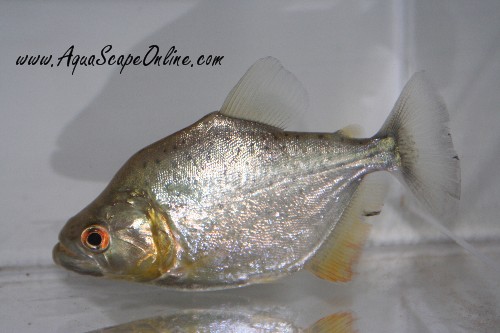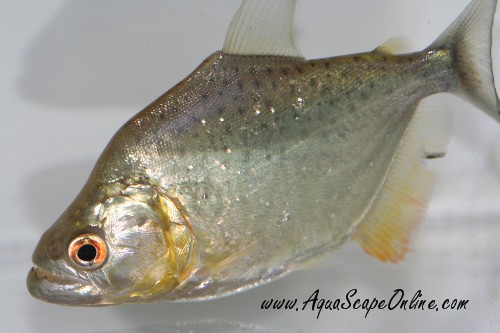No clear terminal band (hyaline edge) on tail fin.
Tank:
Juveniles and sub-adults can be kept in a tank measuring 32x14". Adult fish need a tank of at least 60x20x20" (and even more for very large specimen, 12" and more - fish that big are quite rare in captivity however).
Young Rhombeus Piranha's can be very shy. Therefore, they need a well planted tank with bog wood or rocks to provide shelter. When larger, this species becomes very agressive, and places to hide are no longer really necessary.

Compatible Species:
NONE. Gold Diamonds must be kept in thier own tank due to their super aggressive nature. They make a beautiful show speciman. It is a beautiful site to see the light reflect off their Yellow body when they are swimming in a well lit tank.
Diet:
This species will accept all common food items, like fish (fillets, frozen fish and live feeders), shrimp and other crustaceans, insects and, when large enough, mammals, reptiles and amphibians.
In the wild, this species is a parasitic fin nipper when young, full blown predatory carnivore when older. Will, almost without exception, not tolerate anything else living in its tank. Even much larger fish will be attacked, nipped and injured over and over, until they finally perish.

Comments:
This large, and very powerful species of piranha is not considered dangerous to man in the wild state, but it can deliver extremely painful wounds. It is said that a mature S. Rhombeus is capable of severing a man's hand at the wrist in two or three bites, and given the potential size of this large and very powerful species, it's hard to believe this is a gross exaggeration.
When we are talking about the Rhombeus Piranha, we are actually referring to a complex of several different forms and closely knit species of fish, all with slightly different habits and appearences. Some varieties are the Xingù, Highback and Jet Black Rhombeus. Due to their highly intolerant behavior, these fish should be kept solitary, and are best suited to large display aquariums. In the wild, this species is observed to travel and co-exist in small, loose groups, but in general they prefer a solitary life in the wild.